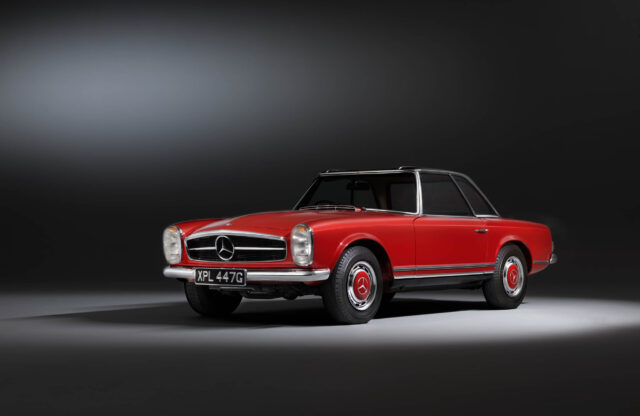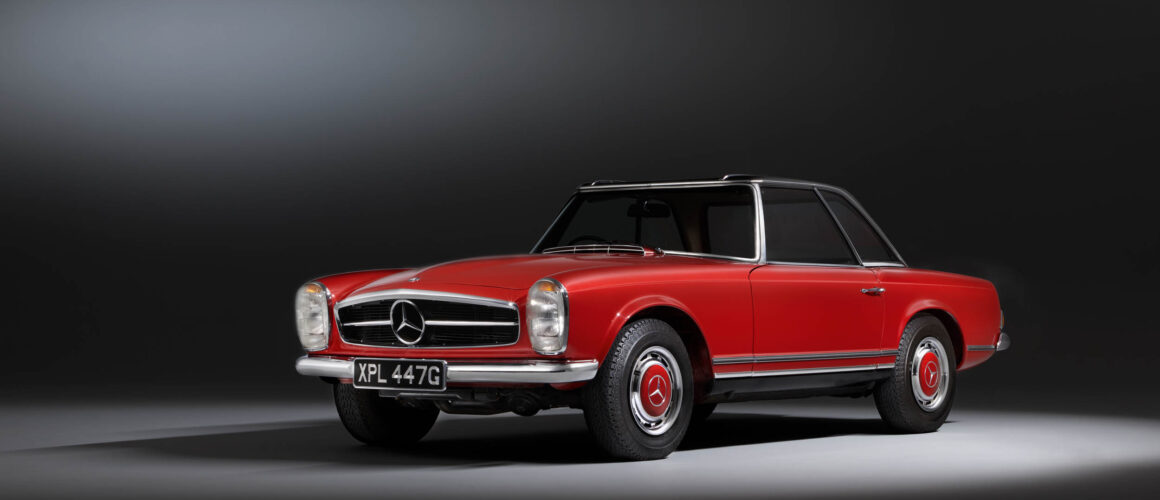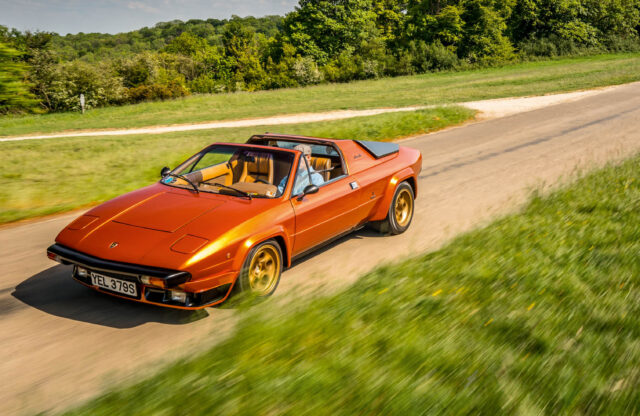The Mercedes SL Pagoda married elegance, strength and sporting capability like few other cars. Here, three Octane advocates explain the simplicity behind its many virtues.
In 1965 a US patent was filed for a ‘motor vehicle with a concave top’. That vehicle was the W113 Mercedes- Benz 230SL, introduced two years before and ever since known as the ‘Pagoda’ on account of an elegant depression in its roof.
To get a sense of the enduring aesthetic thrill of this magnificent car, simply consider its contemporaries that are now largely lost to rust, the crusher and memory. Hillman Imp? Triumph 2000? True, the W113 SL shares a birthday with the original Lamborghini 350GT, but Carrozzeria Touring’s aesthetic is located in the 1950s, while the Mercedes looks fresh nearly 60 years later. The Lamborghini is satin couture and valve technology; the German car is polyester and transistors.
But what have oriental shrines got to do with automobile hardtops? Concave curvatures achieve good strength- weight relationships in structures, as architects of the Horyu-ji temple in Nara knew. But, in 1963, strength and weight relationships were also a preoccupation of safety-obsessed Mercedes.
The SL’s designer, a Bordelais born in 1933 and called Paul Bracq, recently explained (while speaking to camera in a blazer and cravat) that he determined 10cm was the optimum measure of concavity when applied to a car’s roof. Our impressions of cars are formed by minutiae, but never can a mere four inches have contributed so much to perception and reputation. The W113 has many aesthetic and technical virtues, but that pagoda roof made it exceptional. That pagoda roof made history.
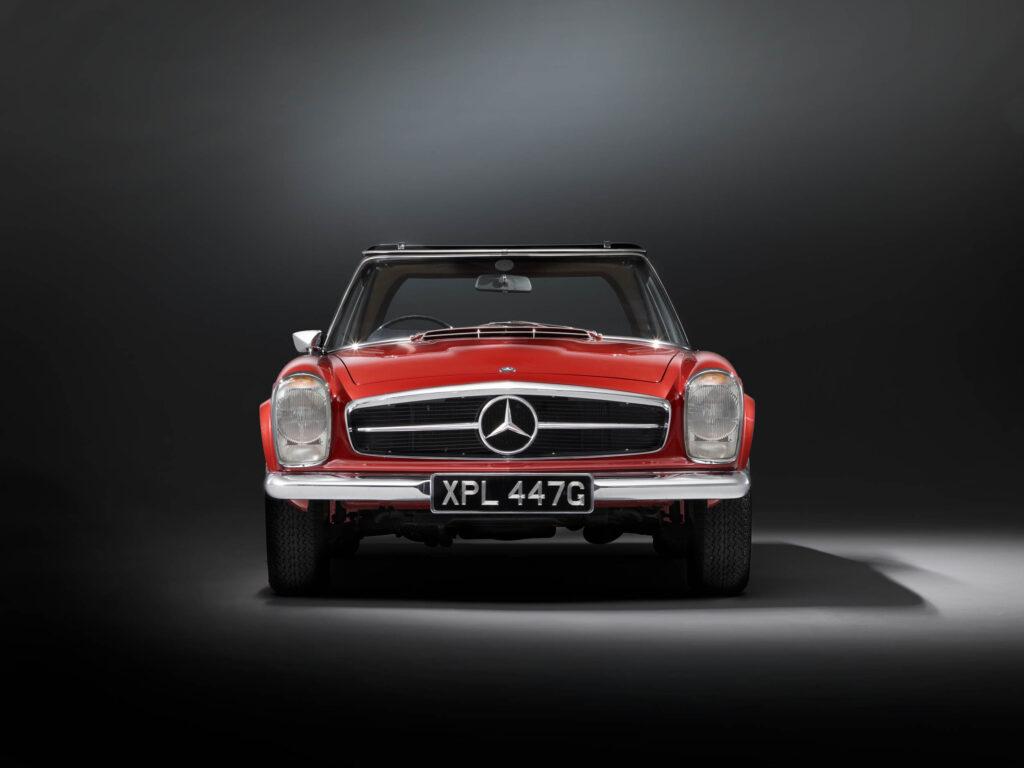
Yet oriental architecture is only one of the elements in the SL’s complicated root-stock of meanings. Bracq’s master was French industrial designer Philippe Charbonneaux, who had done time at GM’s Technical Center in Warren, Michigan, and, before returning to France, contributed to what became the gloriously vulgar ’53 Corvette: Detroit kitsch at its most deranged. Back in France, Charbonneaux created the 1957 Teleavia TV, the pod-like swivelling screen of which predicted Jony Ive’s iMac. Charbonneaux, it may safely be guessed, had an ambition to become Paris’s Raymond Loewy: a slick vulgarian adroit at crowd-pleasers.
Then there are the levels of meaning deposited by the historic owners of any car. John Lennon, flush with royalties from Please Please Me, drove a 230SL. So too did Sophia Loren. Priscilla Presley was given one by her dad and that car is now in the Elvis shrine at Graceland. Audrey Hepburn drove a Pagoda in the 1966 movie Two for the Road and, 14 years later, Helen Mirren was accommodated in a 280SL Pagoda in the gritty Bob Hoskins film The Long Good Friday. It’s fair to say that pop and glamour have played their part in our appreciation of this car.
When Paul Bracq arrived at Sindelfingen from Paris in 1957, the presiding spirits of Mercedes-Benz design were Friedrich Geiger – a ‘test engineer in the styling department’ – and Karl Wilfert, ‘chief of car body development’. These men’s lofty credentials were based on their contribution to the epochal 300SL of 1954. If cars can be read like books, the 300SL was a design encyclopaedia in which every entry was a gem. The W113 SL was its successor.
But even more influential than Geiger and Wilfert was Béla Barényi, one of the great Austro-Hungarian engineers who had made Mercedes-Benz his workshop. A cultured man from a wealthy, opera-loving, officer-class family, Barényi’s obsession was safety. He created the crumple zone, first employed on the tailfin W111 of 1959. He made wipers disappear behind a scuttle: a device that defines genius in engineering, at once clever, practical and beautiful.
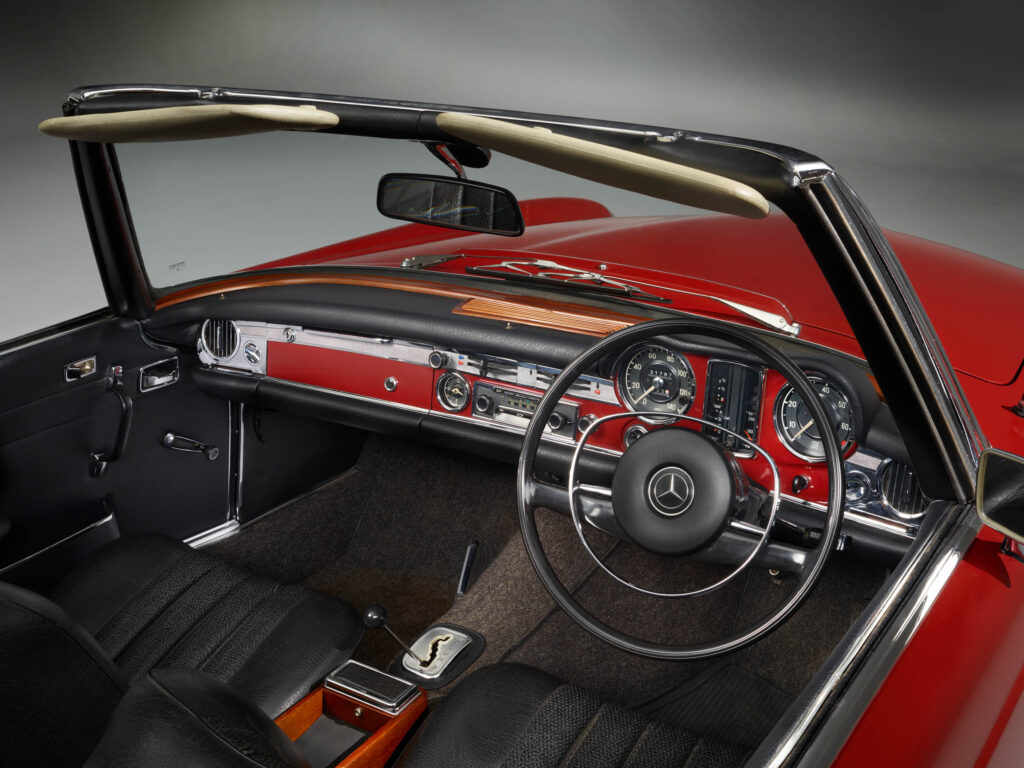
But Barényi has another part in the Mercedes-Benz mythology. The company identifies him as the ‘intellectual father’ of the Volkswagen. Indeed, there are Barényi drawings from 1924-25 of a rear-engined car with a distinctive ‘beetle’ profile. So that was The People’s Car. And the SL Pagoda was The Beautiful People’s Car.
In 1970 Janis Joplin took part in a poetry jam in a New York bar and the result was the song Oh Lord, won’t you buy me a Mercedes-Benz? She died three days after it was recorded. The song may have been a counter-culture satire on consumerism, but the beauty and desirability of the Pagoda cut through the fog in Joplin’s drug-addled brain.
Meanwhile, Wilfert had wanted the car to express stability and visibility: stability was an established Mercedes-Benz value, and visibility was becoming an ever-more-desirable attribute for consumers. It seems that the patent-heavy Barényi, interpreting Wilfert, suggested the pagoda roof to the cravat-wearing Bracq as a means of adding rigidity to an audaciously light and airy glasshouse.
Essentially, what Paul Bracq did was to bring ooh-la-la French style to the very straight Sindelfingen. There are sketches by Geiger that show the general arrangement of a car that must be a predecessor of the W113 SL: it is lean – almost austere – linear and symmetrical in profile, with equal emphasis fore and aft. Bracq developed this conceit in voluptuous renderings that added élan and esprit, but any tendency to Charbonneaux excess and frivolity was ultimately contained by the strict discipline of Mercedes- Benz studio practice. The production car was clicked back several notches from Bracq’s most uninhibited drawings.
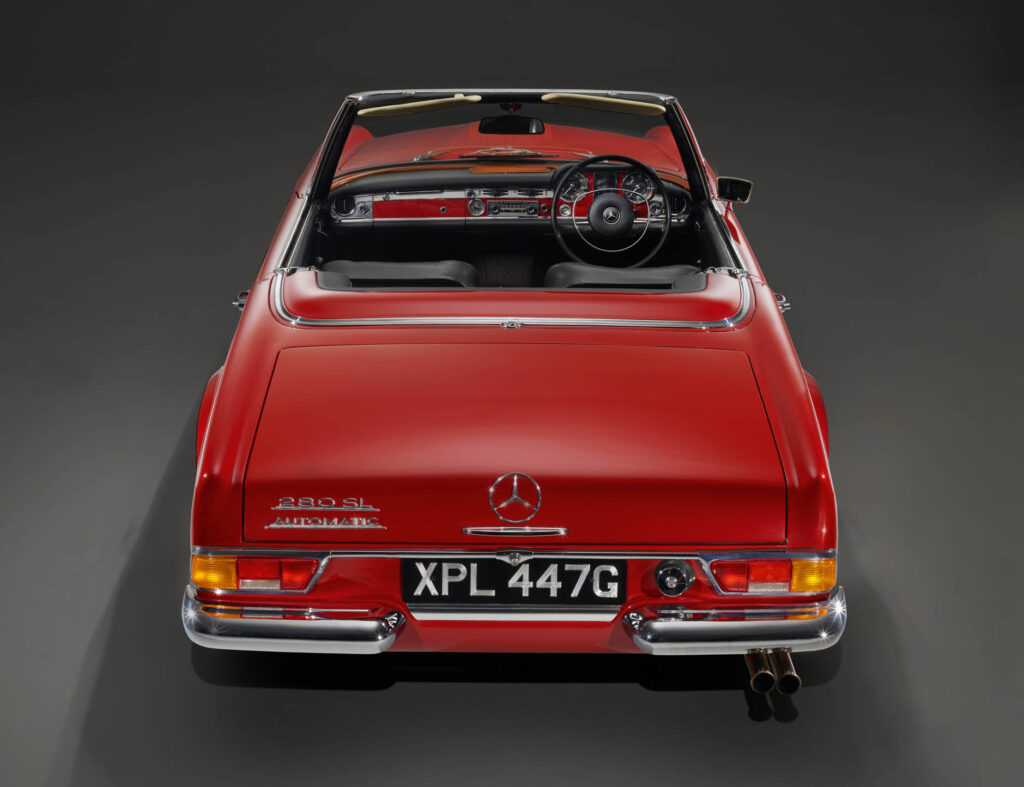
The resulting Franco-German SL Pagoda is a nearly perfect composition: symmetrical in several measures, disciplined and refined. It has a gentleness that could be called reticent and feminine were it not a shape that also expresses the weight and integrity of the car’s engineering. Its slenderness somehow emphasises sturdy foundations. The character lines are wise and subtle, the stance secure yet agile. Lights are pushed out to the corners, adding to the visual tension. There is no flab.
Nothing is done to excess, but nor does the SL look stripped and bare. On the contrary, it looks sophisticated and expensive. That effect is partly to do with the exquisite execution of the car’s jewellery: the application of chrome stops only just short of being lavish, and the perpendicular Bosch headlamps seem somehow to express wisdom and enlightenment. And they also make the car look modern, at least in a rather 1960s fashion. There is nothing that needs to be taken away and nothing that needs to be added. That’s a definition of aesthetic excellence. It is a perfect expression of what it is.
Bracq also drew the colossal Mercedes-Benz 600, as pharaonic and gross as the Pagoda is aristocratic and spare, but nonetheless a car with a surprisingly graceful profile and, again, an exceptionally airy and open glasshouse. Then the designer, impatient, perhaps, with his slow ascent up the Mercedes-Benz hierarchy, returned to France and coachbuilders Brissonneau & Lotz. There, with Jacques Cooper, a Raymond Loewy alumnus, he worked on the design of SNCF’s train à grande vitesse, the TGV.
In 1970 Bracq became design director of BMW. But in Munich, while he established a design language for the 3-series and 5-series, he was a professional calamity, a temperamental outsider: reluctant to contribute to a design process that is essentially collaborative, preferring to sequester himself in his own office, producing drawings in competition with his own staff. Ian Cameron, designer of the superb first BMW Rolls-Royce Phantom, put ‘fame’ in inverted commas when he wrote to me about Bracq. Although he did concede that Bracq’s 1973 BMW Turbo concept with gullwing doors was ‘pretty amazing’.
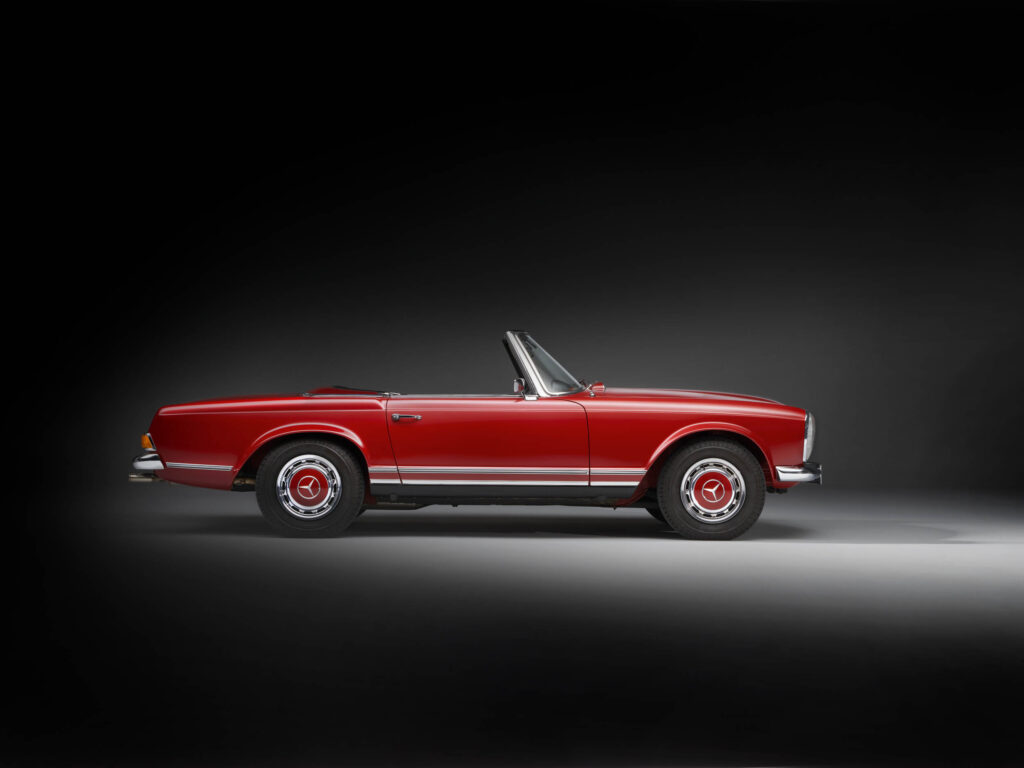
As a result of his unbiddable personality, when Bracq left BMW for Peugeot, his appointment was only as head of interior design. This was partly because of his reputation for being difficult, but also because Pininfarina held the principle Peugeot design account. Instead, Bracq busied himself with his apologia: a book called Carrosserie Passion, which was published in 1990.
I found a copy of this frankly hideous book in a brocante at the flower market in Nice some years ago. The cover is a garish Bracq rendering of realised and unrealised designs, including something a little like a Mercedes-Benz 600, swooshing polychromatically hither and yon. Like an explosion in Philippe Charbonneaux’s rumpus room, the Bracq book demonstrates that exquisite taste in one design discipline does not readily translate into another.
Even if the interior of the long-forgotten Peugeot 604 was an educated take on French notions of luxe, no-one can blame Paul Bracq for not equalling the W113 SL. Someone once said to novelist Joseph Heller: ‘You have never written anything as good as Catch 22.’ Heller replied: ‘True, but nor has anybody else.’ A version of this line would be very useful to Paul Bracq.
The Germans are uneasy with luxury. Henri Racamier, founder of what has become the Earth-girdling grande marque and cashmere conglomerate that is LVMH, once explained that French luxury is feminine – Champagne, frocks and jewels – while English luxury is masculine: whisky, guns and tweed. Racamier had nothing to say about the Germans.
Instead, the German concept of quality is founded more on the structural principles that inform both architecture and engineering. It is a belief that a building or a product that responds intelligently to The Laws of Nature will, almost inevitably, be a thing of beauty.
Of course, there is evidence today that the Germans, perhaps especially Mercedes-Benz, have rather loosened their grip on this fine belief system. But in 1963 it still held good. The architect Heinrich Tessenow believed: ‘The best is always simple, but the simple is not always best.’
And the Pagoda is, as Tina Turner said rather later, simply the best.
Stephen Bayley
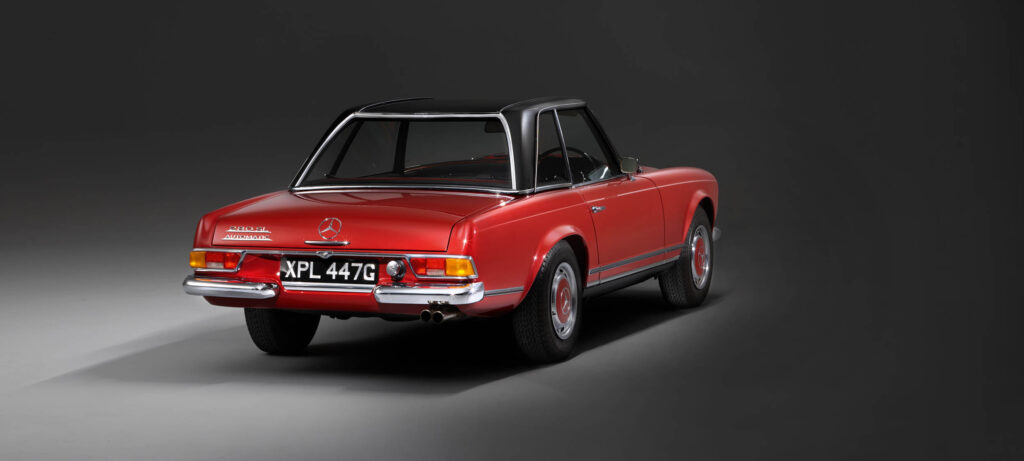
Driving a Pagoda
SportS Leicht. That’s what ‘SL’ stands for. Mercedes- Benz had been there before with the legendary Gullwing, yet it had also (if somewhat disingenuously) applied the same moniker to the 190, a car not unusually light, and certainly not sporting. But it was so elegant. And easy to drive. And had become well-established in European markets and – more especially, and thanks to the way in which Max Hoffman transformed Mercedes-Benz’s image there – in the US, where it was a glamorous German alternative to the likes of the Austin-Healey.
And the Pagoda had to replace both. Which was no small job: a racebred techfest on the one hand, and a boulevardier on the other. Yet the W113 SL was developed under the auspices of Mercedes-Benz technical director Fritz Nallinger and chief engineer Rudolf Uhlenhaut. Their talents had been well-proven, Uhlenhaut’s in racing (the W125 and W154 Silver Arrows were his, as was the W194 that begat the 300SL Gullwing, and the twice F1 Championship-winning W196), while Nallinger had been a leading light in Benz’s R&D department, and was behind the introduction of diesel engines into Mercedes passenger cars in the 1930s. Without either of these men, Mercedes-Benz would not have been anything like so mighty an empire.
In fact, there had been plans to introduce a new car as early as 1957: cheaper than the ultra-exclusive 300SL, more entertaining to drive than the 190 from which it would be developed, with a 2.2-litre straight-six and codenamed W127. But while that project was delayed, along came the far more advanced new S-class, and so Nallinger abandoned the W127 and began development of a new sporting roadster and coupé around a shortened version of the new W111 platform and an enlarged, fuel-injected straight-six.
And thus arrived the Pagoda (in Merc-speak, the W113), as the 230SL, launched to great acclaim at the 1963 Geneva motor show. ‘It was our aim to create a very safe and fast sports car with high performance that, despite its sporting characteristics, provides a very high degree of travelling comfort,’ said Nallinger at the time.
It’s the kind of understatement that would so easily have been overshadowed by the hype surrounding Jaguar’s E-type, launched in the same place two years before. Yet both cars were naturals for the same market: elegant sporting roadster/coupés with enough power to be fabulous fun – and effective in competition too.
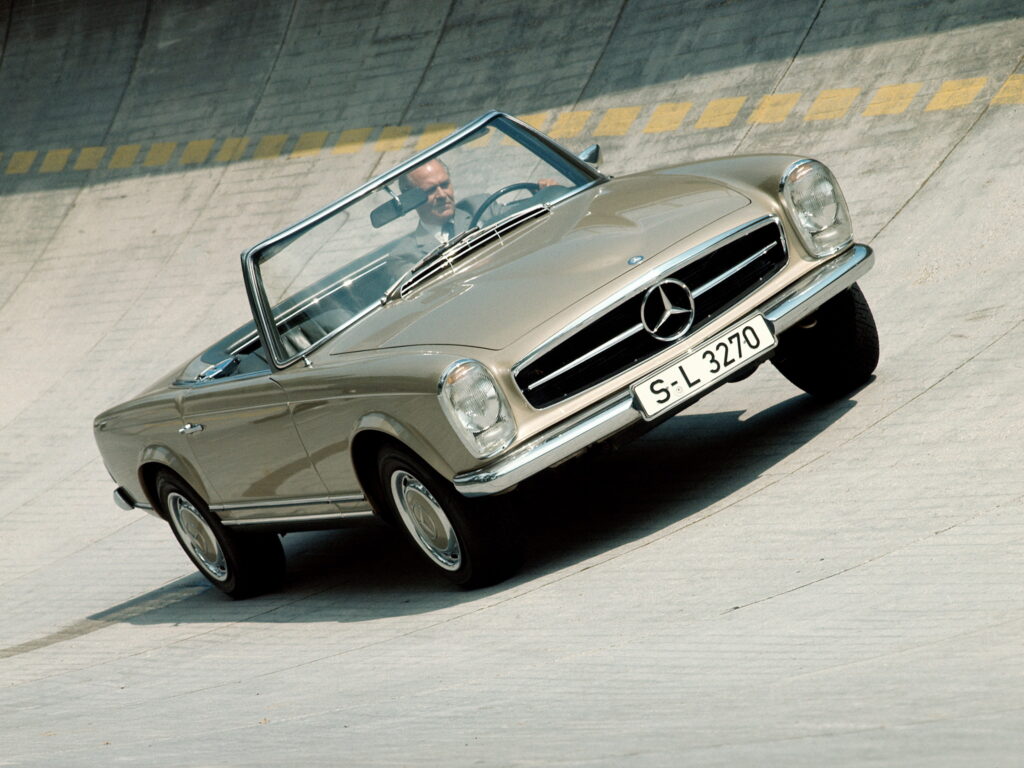
But while you could buy the Jag as either a fixed-head or a roadster, the SL came as both – in one body. That concave roof was removable. Underneath was a folding fabric hood, which hid beneath a hinged tonneau, so you could enjoy the breeze (and the sizzling exhaust note) while sunning yourself, then quickly erect the hood during a cloudburst. There was even a ‘California coupé’ that came only with the removable hardtop and a small pair of rear seats in place of the hood.
That version arrived with the upgraded 250SL of 1966, an interim model that saw the introduction of a 2.5-litre variant of the straight-six with power unchanged at 148bhp but more mid-range torque. Late-1967 models brought some safety improvements, including a collapsible steering column, padding to the inner windscreen frame, removable locking levers for the roof, concave switches, and less intrusive internal doorhandles, locks and window-cranks.
So the original 230SL is the purist’s choice, with the prettiest interior and less adornment outside than on the last-of-line cars. Yet it was still an advanced car, featuring monocoque construction, power brakes with discs up-front (rears came with the 250), all-independent suspension (a clever third compensator spring in the rear suspension quelled the swing axle’s propensity for snap oversteer), and an optional four-speed automatic transmission with a fluid coupling in place of a torque convertor.
The most numerous of the Pagodas was the 2.8-litre 280, which ran from 1967 to 1971, when the R107 took over: 23,855 plays 19,831 230s and only 5226 250s. And, with power up to 168bhp, the option of automatic transmission and the softer suspension that was introduced with those late 250s, it’s the one everyone still wants. Hidden changes such as sealed-for-life suspension components and rubber bushings extended service intervals, and only details such as the shape of the door mirror and new hubcaps differentiated it externally. Needless to say, back in the day, North America was its biggest market: more than half went there, a much larger proportion than was the case with earlier versions.
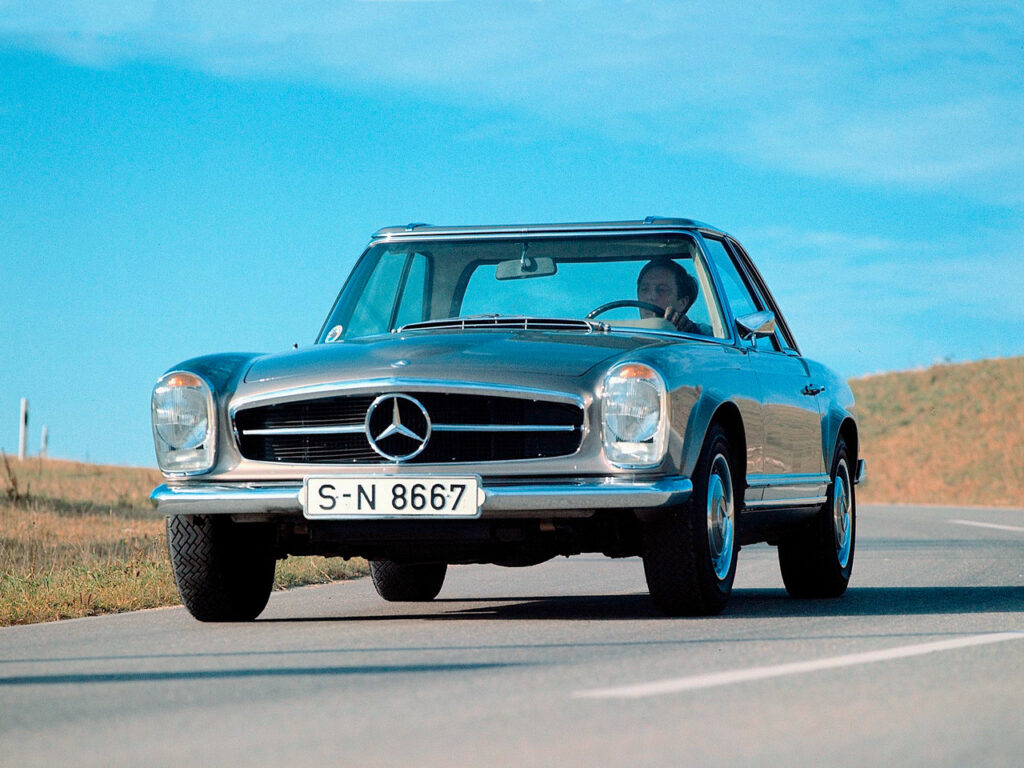
That’s what you’re looking at in these pictures, a 1969 car restored beautifully several years ago, and looking mellow yet resplendent in the studio. But it didn’t arrive here on the back of a truck. In the process of collecting it, driving it to the studio and returning it to its owner, I put some 200 miles on its clock. Spearing along motorways, blasting along country roads, trickling in traffic, and meandering through villages, it felt right at home everywhere. Of course, sunny weather helps. This is one of those cars for which a summer’s day was invented, yet it’s the perfect all-weather car: fit the hardtop and it’s as snug as any 1960s coupé, with proper heating and – more unusually – decent ventilation as well.
Cruising is easy: yes, you can hear the wind ragging at the edges of that roof, but it tracks arrow-straight, has power in hand to overtake, and the engine note is a reassuringly constant background buzz. Yet the car comes alive to a surprising degree when you head into twistier environs.
That large-diameter steering wheel commands the power- assisted recirculating-ball system effortlessly. The car feels broad, corners flat, and rides with suppleness. Its pioneering gear selector, with the Mississippi-like shift pattern copied so many times since, makes it easy to flick between second, third and top to make the most of the straight-six’s eager delivery, and you can regulate each change with the throttle so it engages with less of a lurch than in kickdown mode.
On a particularly enjoyable stretch of bowling B-road, the Pagoda delivers pace, confidence and a big smile. How does it compare to an E-type? Less involving, for sure, and the soundtrack is efficiently mechanical and smooth rather than rousing, but the SL feels like a car from a more modern era: more executive jet than Spitfire. It’s calmer, quieter, easier. And tougher. It feels bomb-proof. Which is everything you’d expect of such a comparison, I guess. And while the Pagoda wasn’t as frequent a sight as an E-type on the tracks, it had success in rallying. As you’re about to find out.
Glen Waddington
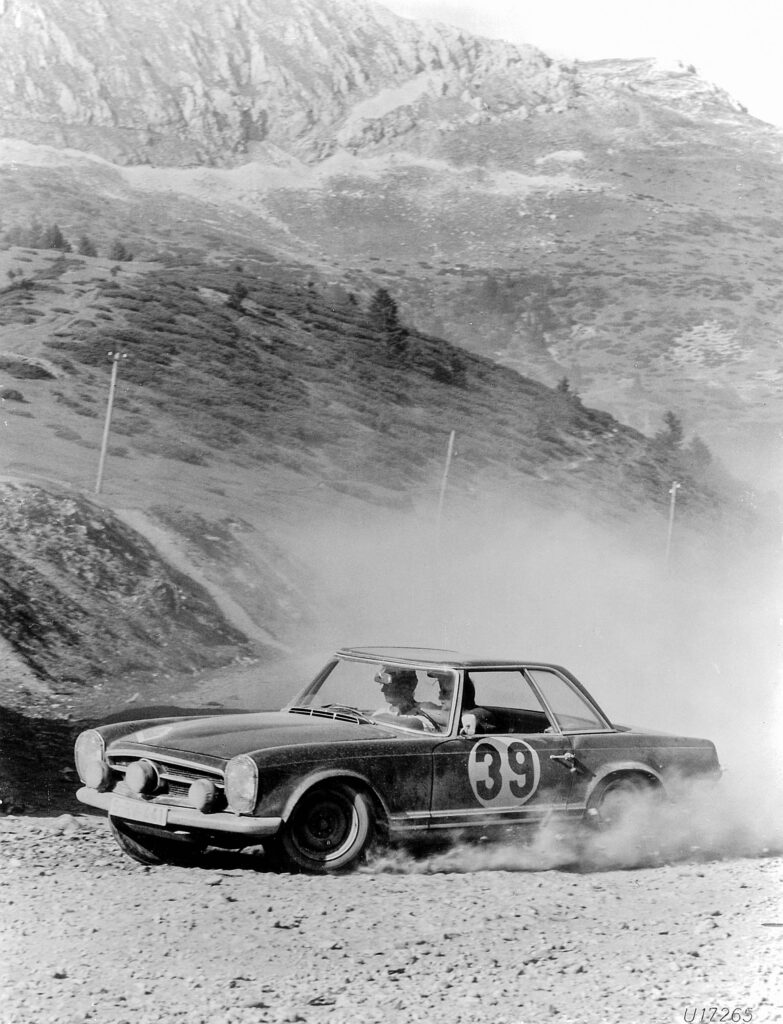
The Pagoda in motorsport
The W113-series Mercedes was not an obvious competition tool by any stretch of the imagination. Nevertheless, its three-pointed star shone in long-distance rallying, and never more so than with Eugen Böhringer at the wheel. The 40-something hotelier and 1962 European Rally Champion had staying power, that’s for sure. He famously won that year’s Liège-Sofia-Liège alongside Hermann Eger aboard a factory-fielded 220SEb saloon. From 100 starters, only 18 cars finished the gruelling, 3419- mile event, which rendered the achievement all the more remarkable. For 1963, however, he and new wingman Klaus Kaiser were armed with a pre-production 230SL, Böhringer aiming to become the first driver ever to claim back-to-back wins in the ‘Marathon de la Route’.
The event marked the competition debut for the model. Physically, this works entry boasted a welded-on hardtop and racy red hue, and beneath the skin it was largely stock mechanically save for sturdier suspension mounts, long- range fuel tanks, and an engine displacement hike from 2.3 to 2.6 litres. It was prepared under the watchful eye of marque legend Erich Waxenberger, the straight-six up front producing an alleged 170bhp at the flywheel. Nevertheless, the car was far from proven.
For the ’63 running, the start took place in Spa, the route taking in the Saarland, Baden-Württemberg and Bavaria before heading to Austria, Italy and Yugoslavia. There was a minor detour to Romania, which was followed by a brief stop in Sofia. The return leg encompassed Yugoslavia and Italy, with the small matter of Alpine passes to contend with. Böhringer had a minor ‘off’ in Dubrovnik, but it cost him only two minutes. Heading towards Rovereto, the Mercedes duo were preceded by Rauno Aaltonen and Tony Ambrose in their BMC Competitions Department Austin-Healey. On the Vivione Pass, however, the Anglo-Finnish pairing had an accident and retired on the spot. Böhringer and Kaiser assumed the lead and maintained it to the end in Belgium.
Autosport enthused: ‘As last year’s winner, Böhringer started among the favourites for the 1963 Marathon de la Route, but the fact that he was driving a new car, as yet untried in competition, did not particularly encourage his supporters… [Nevertheless] Böhringer chalked up his second successive victory in this most arduous event, he and Kaiser putting up a fantastic performance in the beautiful new 230SL to drop only eight minutes in an event of over 93 hours’ duration, which covered over 3430 miles.’
The duo finished 15 minutes ahead of Saab stalwarts Erik Carlsson and Gunnar Palm. Only 20 cars made the finish from 128 starters. What’s more, the winning 230SL – complete with battle scars – was displayed on the Mercedes- Benz stand at the Frankfurt motor show later that year. This remarkable win first time out marked the high point for the Pagoda in top-flight motorsport. Böhringer and Kaiser campaigned a works SL in the final Spa-Sofia-Liège staged 12 months later, and finished an embattled third. But the Pagoda’s reputation had already been cemented.
A worthy successor to the 300SL and the 190SL? With that roll-call of legendary stylists, engineers and drivers behind it, it’s doubtful that Mercedes-Benz could have done it better.
Richard Heseltine
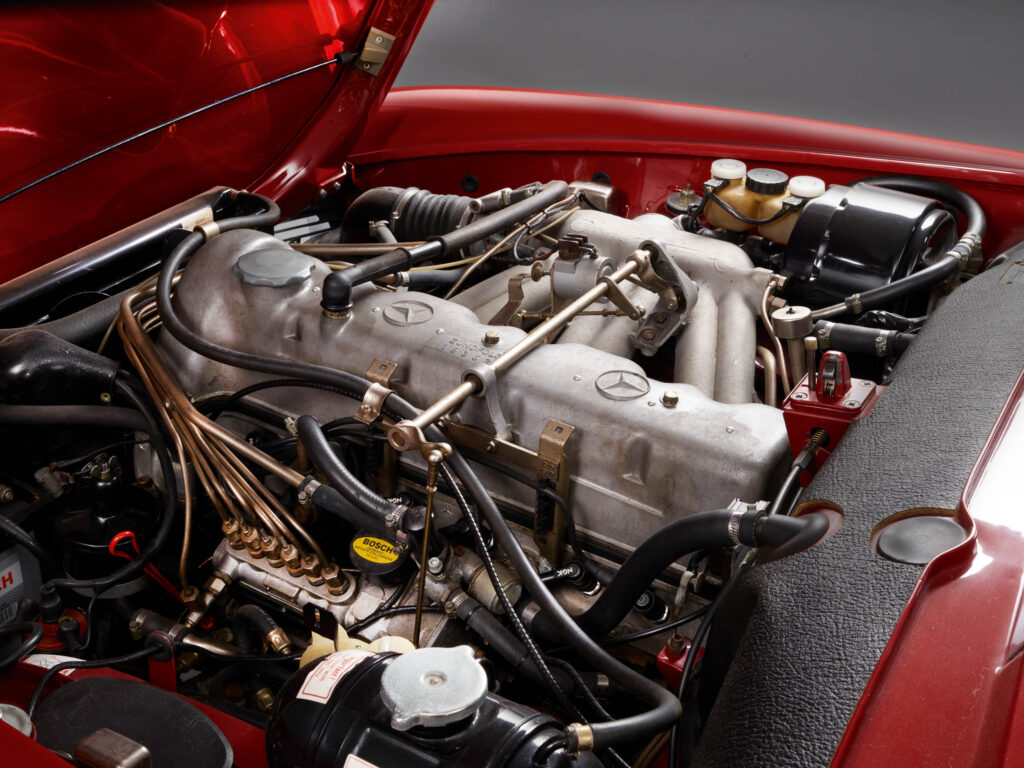
1969 Mercedes-Benz 280SL ‘Pagoda’ specifications
Engine 2778cc straight-six, OHC, Bosch fuel injection
Power 168bhp @ 5750rpm
Torque 177lb ft @ 4500rpm
Transmission Four-speed manual (optional five-speed manual or four-speed automatic), rear-wheel drive
Steering Recirculating ball, power-assisted
Suspension Front: double wishbones, coil springs, telescopic dampers, anti-roll bar. Rear: swing axle, coil springs, transverse compensator spring, telescopic dampers
Brakes Discs
Weight 1360kg
Top speed 124mph
0-60mph 8.5sec
